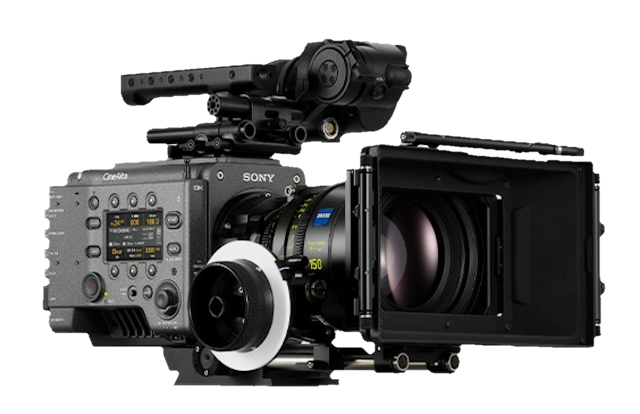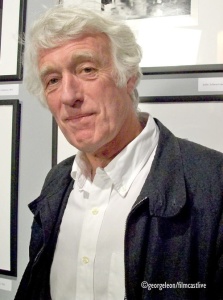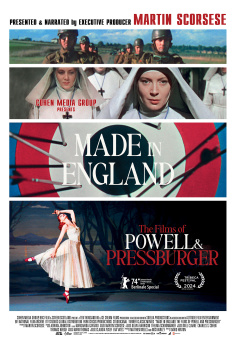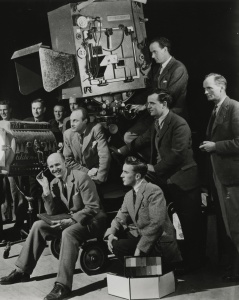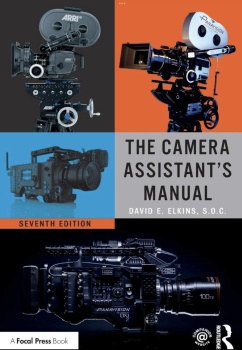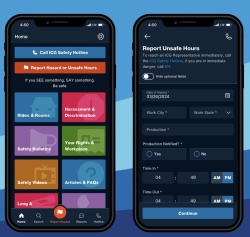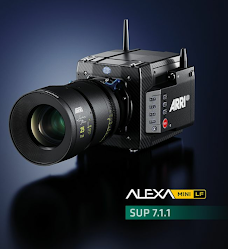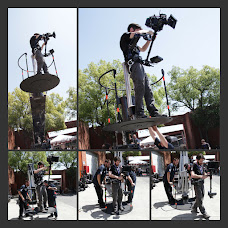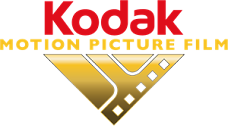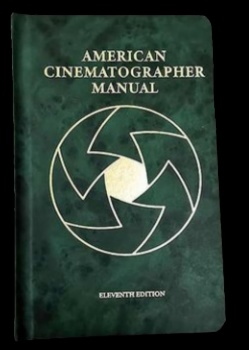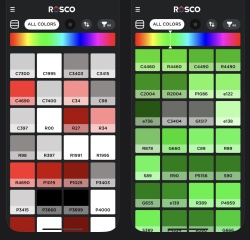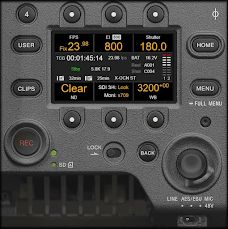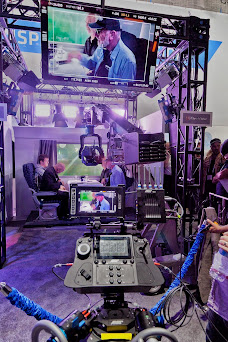A Short Story about Director's Viewfinders.
Armed with these early viewfinders, they used cut-out mattes to represent the focal lengths of various lenses. The studio machine shops even developed a zooming device for use with the early viewfinders. Several versions of directors viewfinders were developed during this time. Just after World War II in 1946, Tewe, a German optical company, developed a small viewfinder which could be hung around the neck. It was soon being used and worn by directors and D.P.'s throughout the motion picture industry around the world.
 Orson Wells & Cinematographer Gregg Toland lining up
Orson Wells & Cinematographer Gregg Toland lining up Tewe Director's Viewfinder Model 3B, circa 1970
Tewe Director's Viewfinder Model 3B, circa 1970In 1975, Alan Gordon Enterprises in Hollywood, California started the development of what would become the 10:1 Mark IV Directors Viewfinder. The Mark IV was introduced at the S.M.P.T.E. conference and trade show in 1979. This was the beginning of the modern day Director's Viewfinder. Subsequent updated models have been the Mark V, introduced in 1991 and the current Mark Vb model in 2005. In addition to its 10:1 zoom range, the Mark IV featured windows through which the director could easily see the lens focal length he was considering. These windows represented 16, 35 & 35 anamorphic formats, and gave the cinematographer instant information about lens focal length and scene framing.
Mark IV evolved into Mark V Director's Viewfinder in 1987. With the Mark V, Alan Gordon Enterprises introduced an enhanced 12:1 zoom range, a wider angle capability, and two additional windows covering Super 16, 1/2" & 2/3" video formats.
TODAY'S DIRECTOR VIEWFINDERS
 The Mark Vb Director's Viewfinder represents the industry's state-of-the-art. It precisely defines choice of lenses, angles and coverage in a wide variety of formats for both film and video. The Mark Vb enables film professionals to communicate their visions to each other instantly and with complete accuracy, allowing the time saved to be used in the art of film-making. With a 12:1 zoom ratio, the Mark Vb Director's Viewfinder addresses all framing situations, making it an essential tool for today's professional filmmaker. Setting up shots using the 16mm and 35mm direct-reading windows provides a wide range of film and video formats including 2/3", and Super 16.
The Mark Vb Director's Viewfinder represents the industry's state-of-the-art. It precisely defines choice of lenses, angles and coverage in a wide variety of formats for both film and video. The Mark Vb enables film professionals to communicate their visions to each other instantly and with complete accuracy, allowing the time saved to be used in the art of film-making. With a 12:1 zoom ratio, the Mark Vb Director's Viewfinder addresses all framing situations, making it an essential tool for today's professional filmmaker. Setting up shots using the 16mm and 35mm direct-reading windows provides a wide range of film and video formats including 2/3", and Super 16. Michael Bay's engraved Mark VB by Panavision
Michael Bay's engraved Mark VB by Panavision The Fries/Mitchell "Special Effects 35mm Director's Viewfinder" is a highly customizable and flexible system. The standard finder comes with your choice of lens mount, Arri-PL, Panavision or BNC-R, (1) ground glass, handle, rubber eye cup and case. The mount is easily changed and re-centered for Standard and Super 35 formats. Inside the finder is a set of registration pins to hold a film clip.
The Fries/Mitchell "Special Effects 35mm Director's Viewfinder" is a highly customizable and flexible system. The standard finder comes with your choice of lens mount, Arri-PL, Panavision or BNC-R, (1) ground glass, handle, rubber eye cup and case. The mount is easily changed and re-centered for Standard and Super 35 formats. Inside the finder is a set of registration pins to hold a film clip. The Panavision Mini-DV Director’s Viewfinder, made in Australia, uses Panavision Millennium 35mm camera ground glasses. The ground glass image can be viewed through a color viewfinder or flip-out colour LCD monitor and instantly recorded to high quality digital video or stills. An on-board microphone enables the recording of location sound or commentary.
The Panavision Mini-DV Director’s Viewfinder, made in Australia, uses Panavision Millennium 35mm camera ground glasses. The ground glass image can be viewed through a color viewfinder or flip-out colour LCD monitor and instantly recorded to high quality digital video or stills. An on-board microphone enables the recording of location sound or commentary. This high-end director's viewfinder allows you to use your actual camera lens to view and set shots. The OIC-35 is a precise instrument which was conceived for the rough environment of a film shoot, the housing is a light alloy, hermetically sealed and fitted with a 54 PL mount (BNC socket available).
Features: Specially computed and designed optical light path. Ergonomic eyepiece with diopter balance from -4 to +4 . Eyepiece adjustable for right or left eye. Ergonomically designed cherry wood handle, for left or right hand or universal grip. Carrying belt, made of fine nappa leather. Delivered without ground glass (Arri 435/535)
ergonomically designed optical viewfinder system with
spherical and anamorphic capabilities.
The viewfinder is compatible with all sensor formats up to Red Monstro 8K and features interchangeable lens mounts. Current squeeze factors are 1.5x and 1.9x. (1.9x covers 1.8x and 2.0x squeeze factors).
Users can create customized frame lines by using a provided app, printing on acetate slides and inserting them into the ground-glass system. The viewfinder features a pivoting handle grip to aid counterbalance and an adjustable eyepiece diopter.
The UltiMate 16 is a director's finder that features multiple 16mm camera type/format-type ground glasses, interchangeable lens mountings, an optional 1/2" CCD-ready B&W or color video-tap, and provides in-the-view-finder images that are "full-frame." The video-tap (12V power supplied by on-board batteries or an external source), gives behind-the-scene parties the opportunity to view and comment on the shot. Used for location scouting or scene testing, the UltiMate can record specific shots, then return to the production facility for playback and analysis. On the set, the UltiMate finder can help set up the next shot while the current set is being filmed.
LFDV-SET1 includes Full Frame Module only. Additional modules are available for Super-35 and VistaVision formats. The Lindsey Optics Large Format Optical Viewfinder provides optical through the lens viewing for an unprecedented range of formats from Super-35 to Red Monstro and ARRI Alexa 65.
At the heart of the LF Viewfinder design are interchangeable modules for quick and easy tool-free format changes. With a push of the red button, each module slips in and out of the LF body and securely nests in place. Available modules include Large Format (ARRI Alexa 65) VistaVision (RED Monstro 8K), Full Frame (Sony Venice) and Super 35. Ground glasses attache magnetically to the modules. Ground glasses are marked with format frame lines using the included Ground Glass Marking Jig (template) kit. The LF Viewfinder features an LPL lens mount and includes an LPL to PL adapter. The Eyepiece provides diopter adjustment from -4 to +4 diopter.
The LF is designed for intuitive and comfortable balance regardless of changing loads. The NATO Rails on the base of the viewfinder and on the base of the optional handle extension provide balance adjustment. The contoured oak Handle offers a firm and comfortable grip while the Handle Pivot knob activates rosette adjustment. Format frame lines are marked on the ground glass with pencil using marking jigs (templets) A Ground Glass Marking Jig Set is included with the LFDV Set.
Key Highlights: Handheld Director's Viewfinder, PL Mount, Includes ARRIFLEX 435 Ground Glass.
Denz OIC-35A Director’s Viewfinder
Director‘s viewfinder for anamorphic & spherical lenses. Interchangeable anamorphic / shperical settings. Available with PL or PV hard mount. Flexible eyepiece with +/- 5 dpt diopter adjustment.
Ergonomic universal handgrip, made of cherrywood, with DENZ Soft-Touch coating and quick-adjustment locking rosettes for ideal adjustment of the handle with anti-twist using DENZ keying system
Special extension bracket made of AW7075 aluminum for optimal balance with larger lenses; three mounting points for handgrip with 1/4" thread on bottom of handgrip for monopod useDENZ ground glass: 1:1.78 / 1:2.35 with 1:1.85 / SCOPE 1:2.39 with 1:1.33 / with center mark/cross.
















